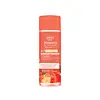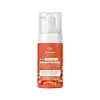What's inside
What's inside
 Key Ingredients
Key Ingredients

 Benefits
Benefits

 Concerns
Concerns

 Ingredients Side-by-side
Ingredients Side-by-side

Water
Skin ConditioningGlycerin
HumectantPropylene Glycol
HumectantHyaluronic Acid
HumectantMethyl Gluceth-20
HumectantPEG-60 Hydrogenated Castor Oil
EmulsifyingSolanum Lycopersicum Meristem Cell
AntioxidantLactobacillus/Tomato Fruit Ferment Extract
Skin ConditioningPhenoxyethanol
PreservativeNiacinamide
SmoothingXanthan Gum
EmulsifyingBetaine
HumectantParfum
MaskingCitric Acid
BufferingTrehalose
HumectantAllantoin
Skin ConditioningPanthenol
Skin ConditioningDisodium EDTA
Arbutin
AntioxidantTocopheryl Acetate
AntioxidantSorbic Acid
PreservativeHydrolyzed Hyaluronic Acid
HumectantAscorbyl Glucoside
AntioxidantWater, Glycerin, Propylene Glycol, Hyaluronic Acid, Methyl Gluceth-20, PEG-60 Hydrogenated Castor Oil, Solanum Lycopersicum Meristem Cell, Lactobacillus/Tomato Fruit Ferment Extract, Phenoxyethanol, Niacinamide, Xanthan Gum, Betaine, Parfum, Citric Acid, Trehalose, Allantoin, Panthenol, Disodium EDTA, Arbutin, Tocopheryl Acetate, Sorbic Acid, Hydrolyzed Hyaluronic Acid, Ascorbyl Glucoside
Water
Skin ConditioningCocamidopropyl Betaine
CleansingButylene Glycol
HumectantMethyl Gluceth-20
HumectantHyaluronic Acid
HumectantHydrolyzed Collagen
EmollientPEG-60 Hydrogenated Castor Oil
EmulsifyingSolanum Lycopersicum Fruit Extract
AntioxidantCentella Asiatica Extract
CleansingPhenoxyethanol
PreservativeParfum
MaskingAllantoin
Skin ConditioningChlorphenesin
AntimicrobialPEG-12 Dimethicone
Skin ConditioningMelaleuca Alternifolia Leaf Extract
PerfumingVitis Vinifera Fruit Extract
Skin ConditioningHamamelis Virginiana Leaf Extract
Skin ConditioningCitric Acid
BufferingGlycyrrhiza Glabra Root Extract
BleachingMorus Alba Bark Extract
Skin ConditioningArbutin
AntioxidantDisodium EDTA
Portulaca Oleracea Extract
Skin ConditioningHydrolyzed Hyaluronic Acid
HumectantAscorbyl Glucoside
AntioxidantAscorbic Acid
AntioxidantWater, Cocamidopropyl Betaine, Butylene Glycol, Methyl Gluceth-20, Hyaluronic Acid, Hydrolyzed Collagen, PEG-60 Hydrogenated Castor Oil, Solanum Lycopersicum Fruit Extract, Centella Asiatica Extract, Phenoxyethanol, Parfum, Allantoin, Chlorphenesin, PEG-12 Dimethicone, Melaleuca Alternifolia Leaf Extract, Vitis Vinifera Fruit Extract, Hamamelis Virginiana Leaf Extract, Citric Acid, Glycyrrhiza Glabra Root Extract, Morus Alba Bark Extract, Arbutin, Disodium EDTA, Portulaca Oleracea Extract, Hydrolyzed Hyaluronic Acid, Ascorbyl Glucoside, Ascorbic Acid
 Reviews
Reviews

Ingredients Explained
These ingredients are found in both products.
Ingredients higher up in an ingredient list are typically present in a larger amount.
Allantoin is a soothing ingredient known for its protective and moisturizingg properties. Because of this, it is often added to products with strong active ingredients.
Studies show higher concentrations of this ingredient can promote wound healing.
Though it can be derived from the comfrey plant, allantoin is produced synthetically for cosmetic products to ensure purity.
Learn more about AllantoinArbutin is derived from the bearberry plant. It helps even out skin tone and reduce hyperpigmentation.
This ingredient has the ability to block tyrosinase, an enzyme that starts the process of skin darkening. When applied to the skin, arbutin works at a slow pace. This can make it less irritating than similar ingredients.
Kojic Acid is a similar ingredient.
Learn more about ArbutinAscorbyl Glucoside is a stable form of Vitamin C. It is created by combining glucose from starch.
When applied to skin, Ascorbyl Glucoside turns into Ascorbic Acid.
Ascorbyl Glucoside is an antioxidant. Antioxidants help fight free-radicals, or molecules that may damage skin cells.
It can help to reduce redness, improve skin texture, reduce the effects of aging, reduce the visibility of dark spots, and brighten skin.
Read more about other types of Vitamin C:
Learn more about Ascorbyl GlucosideCitric Acid is an alpha hydroxy acid (AHA) naturally found in citrus fruits like oranges, lemons, and limes.
Like other AHAs, citric acid can exfoliate skin by breaking down the bonds that hold dead skin cells together. This helps reveal smoother and brighter skin underneath.
However, this exfoliating effect only happens at high concentrations (20%) which can be hard to find in cosmetic products.
Due to this, citric acid is usually included in small amounts as a pH adjuster. This helps keep products slightly more acidic and compatible with skin's natural pH.
In skincare formulas, citric acid can:
While it can provide some skin benefits, research shows lactic acid and glycolic acid are generally more effective and less irritating exfoliants.
Most citric acid used in skincare today is made by fermenting sugars (usually from molasses). This synthetic version is identical to the natural citrus form but easier to stabilize and use in formulations.
Read more about some other popular AHA's here:
Learn more about Citric AcidDisodium EDTA plays a role in making products more stable by aiding other preservatives.
It is a chelating agent, meaning it neutralizes metal ions that may be found in a product.
Disodium EDTA is a salt of edetic acid and is found to be safe in cosmetic ingredients.
Learn more about Disodium EDTAHyaluronic acid is naturally found in healthy skin. It is a humectant, meaning it draws moisture to your skin.
This ingredient helps hydrate, soothe, and protect the skin.
What makes hyaluronic acid so hydrating? It has the capacity to bind or hold large amounts of water.
Fun fact: It is already naturally found in our bodies, such as the fluids of our eyes and our joints.
Studies find this ingredient to have anti-inflammatory and anti-microbial properties. This can help speed up wound-healing.
Hyaluronic acid can be irritating if the molecule has a low-molecular weight, or if the molecules are small.
One study found low-molecular weight hyaluronic acid to be pro-inflammatory, meaning some people may experience irritation. This is because our bodies use hyaluronic acid in the wound-healing process to signal to our bodies, via irritation, that something needs healing.
The same study found high-molecular weight hyaluronic acid to be anti-inflammatory.
These are some other common types of Hyaluronic Acid:
Learn more about Hyaluronic AcidHydrolyzed Hyaluronic Acid is a form of hyaluronic acid. It is created by the hydrolysis of hyaluronic acid with a high molecular weight. Once created, Hydrolyzed Hyaluronic Acid has a low molecular weight.
Low molecular weight HA has been shown to hydrate and increase elasticity of the skin. Increasing elasticity is also associated with reduction of wrinkle depth.
One study found topical low molecular weight hyaluronic acid may be considered for the treatment of rosacea in the adult population. However, we always recommend speaking with a professional about your skin concerns.
Hyaluronic acids are a humectant. This means they draw moisture from the air. Hyaluronic acids help moisturize, soothe, and protect the skin.
Read more about other common forms of hyaluronic acid:
Learn more about Hydrolyzed Hyaluronic AcidMethyl Gluceth-20 is a humectant. Humectants help draw moisture from the air to your skin.
It is created by combining polyethylene glycol with glucose.
Parfum is a catch-all term for an ingredient or more that is used to give a scent to products.
Also called "fragrance", this ingredient can be a blend of hundreds of chemicals or plant oils. This means every product with "fragrance" or "parfum" in the ingredients list is a different mixture.
For instance, Habanolide is a proprietary trade name for a specific aroma chemical. When used as a fragrance ingredient in cosmetics, most aroma chemicals fall under the broad labeling category of “FRAGRANCE” or “PARFUM” according to EU and US regulations.
The term 'parfum' or 'fragrance' is not regulated in many countries. In many cases, it is up to the brand to define this term.
For instance, many brands choose to label themselves as "fragrance-free" because they are not using synthetic fragrances. However, their products may still contain ingredients such as essential oils that are considered a fragrance by INCI standards.
One example is Calendula flower extract. Calendula is an essential oil that still imparts a scent or 'fragrance'.
Depending on the blend, the ingredients in the mixture can cause allergies and sensitivities on the skin. Some ingredients that are known EU allergens include linalool and citronellol.
Parfum can also be used to mask or cover an unpleasant scent.
The bottom line is: not all fragrances/parfum/ingredients are created equally. If you are worried about fragrances, we recommend taking a closer look at an ingredient. And of course, we always recommend speaking with a professional.
Learn more about ParfumPeg-60 Hydrogenated Castor Oil comes from hydrogenated castor oil. It is a solubilizer and emulsifier.
As a solubilizer, it helps dissolve ingredients into a water-based version. It is also an emulsifer. Emulsifier help prevent oils and water from separating. Both these properties help create evenly-spread and uniform products.
Basically, Peg-60 Hydrogenated Castor Oil helps hold ingredients together.
Learn more about PEG-60 Hydrogenated Castor OilPhenoxyethanol is a preservative that has germicide, antimicrobial, and aromatic properties. Studies show that phenoxyethanol can prevent microbial growth. By itself, it has a scent that is similar to that of a rose.
It's often used in formulations along with Caprylyl Glycol to preserve the shelf life of products.
Water. It's the most common cosmetic ingredient of all. You'll usually see it at the top of ingredient lists, meaning that it makes up the largest part of the product.
So why is it so popular? Water most often acts as a solvent - this means that it helps dissolve other ingredients into the formulation.
You'll also recognize water as that liquid we all need to stay alive. If you see this, drink a glass of water. Stay hydrated!
Learn more about Water